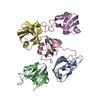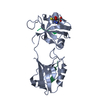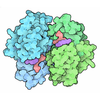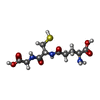[English] 日本語
 Yorodumi
Yorodumi- PDB-6spz: Crystal structure of PDZ1-2 from PSD-95 with peptide ligand seque... -
+ Open data
Open data
- Basic information
Basic information
| Entry | Database: PDB / ID: 6spz | ||||||
|---|---|---|---|---|---|---|---|
| Title | Crystal structure of PDZ1-2 from PSD-95 with peptide ligand sequence RRESEI bound to both domains | ||||||
 Components Components |
| ||||||
 Keywords Keywords | STRUCTURAL PROTEIN / PSD-95 fragment / clustering / protein-complex / receptor-binding / membrane associated | ||||||
| Function / homology |  Function and homology information Function and homology informationSensory perception of sour taste / Classical Kir channels / regulation of skeletal muscle contraction via regulation of action potential / relaxation of skeletal muscle / LGI-ADAM interactions / magnesium ion transport / voltage-gated potassium channel activity involved in cardiac muscle cell action potential repolarization / P2Y1 nucleotide receptor binding / Phase 4 - resting membrane potential / beta-1 adrenergic receptor binding ...Sensory perception of sour taste / Classical Kir channels / regulation of skeletal muscle contraction via regulation of action potential / relaxation of skeletal muscle / LGI-ADAM interactions / magnesium ion transport / voltage-gated potassium channel activity involved in cardiac muscle cell action potential repolarization / P2Y1 nucleotide receptor binding / Phase 4 - resting membrane potential / beta-1 adrenergic receptor binding / membrane repolarization during action potential / neuroligin family protein binding / regulation of grooming behavior / NrCAM interactions / synaptic vesicle maturation / positive regulation of neuron projection arborization / receptor localization to synapse / membrane repolarization during cardiac muscle cell action potential / regulation of membrane repolarization / membrane depolarization during cardiac muscle cell action potential / vocalization behavior / regulation of resting membrane potential / neuron spine / cerebellar mossy fiber / AMPA glutamate receptor clustering / Synaptic adhesion-like molecules / protein localization to synapse / establishment or maintenance of epithelial cell apical/basal polarity / regulation of monoatomic ion transmembrane transport / Trafficking of AMPA receptors / dendritic spine morphogenesis / inward rectifier potassium channel activity / negative regulation of receptor internalization / positive regulation of potassium ion transmembrane transport / neuron projection terminus / juxtaparanode region of axon / acetylcholine receptor binding / cardiac muscle cell action potential involved in contraction / RHO GTPases activate CIT / cellular response to potassium ion / regulation of cardiac muscle cell contraction / Assembly and cell surface presentation of NMDA receptors / NMDA selective glutamate receptor signaling pathway / relaxation of cardiac muscle / Neurexins and neuroligins / Activation of Ca-permeable Kainate Receptor / neuromuscular process controlling balance / neurotransmitter receptor localization to postsynaptic specialization membrane / cortical cytoskeleton / Negative regulation of NMDA receptor-mediated neuronal transmission / potassium ion import across plasma membrane / Unblocking of NMDA receptors, glutamate binding and activation / intracellular potassium ion homeostasis / regulation of heart rate by cardiac conduction / locomotory exploration behavior / AMPA glutamate receptor complex / Signaling by ERBB4 / Long-term potentiation / intercalated disc / excitatory synapse / social behavior / positive regulation of excitatory postsynaptic potential / positive regulation of synaptic transmission / D1 dopamine receptor binding / regulation of postsynaptic membrane neurotransmitter receptor levels / phosphatidylinositol-4,5-bisphosphate binding / voltage-gated potassium channel complex / ionotropic glutamate receptor binding / potassium ion transmembrane transport / T-tubule / dendrite cytoplasm / Ras activation upon Ca2+ influx through NMDA receptor / synaptic membrane / learning / adherens junction / PDZ domain binding / neuromuscular junction / establishment of protein localization / cellular response to mechanical stimulus / cell-cell adhesion / regulation of long-term neuronal synaptic plasticity / postsynaptic density membrane / potassium ion transport / kinase binding / Activation of G protein gated Potassium channels / Inhibition of voltage gated Ca2+ channels via Gbeta/gamma subunits / synaptic vesicle / endocytic vesicle membrane / cell junction / nervous system development / positive regulation of cytosolic calcium ion concentration / RAF/MAP kinase cascade / protein-containing complex assembly / scaffold protein binding / protein phosphatase binding / protein homotetramerization / dendritic spine / chemical synaptic transmission / postsynaptic membrane / neuron projection Similarity search - Function | ||||||
| Biological species |  Homo sapiens (human) Homo sapiens (human) | ||||||
| Method |  X-RAY DIFFRACTION / X-RAY DIFFRACTION /  SYNCHROTRON / SYNCHROTRON /  MOLECULAR REPLACEMENT / Resolution: 2.08 Å MOLECULAR REPLACEMENT / Resolution: 2.08 Å | ||||||
 Authors Authors | Rodzli, N. / Levy, C.W. / Prince, S.M. | ||||||
 Citation Citation |  Journal: Biophys.J. / Year: 2020 Journal: Biophys.J. / Year: 2020Title: The Dual PDZ Domain from Postsynaptic Density Protein 95 Forms a Scaffold with Peptide Ligand. Authors: Rodzli, N.A. / Lockhart-Cairns, M.P. / Levy, C.W. / Chipperfield, J. / Bird, L. / Baldock, C. / Prince, S.M. #1:  Journal: Biorxiv / Year: 2019 Journal: Biorxiv / Year: 2019Title: How the dual PDZ domain from Postsynaptic density protein 95 clusters ion channels and receptors. Authors: Rodzli, N. / Lockhart-Cairns, M.P. / Levy, C.W. / Chipperfield, J. / Bird, L. / Baldock, C. / Prince, S.M. | ||||||
| History |
|
- Structure visualization
Structure visualization
| Structure viewer | Molecule:  Molmil Molmil Jmol/JSmol Jmol/JSmol |
|---|
- Downloads & links
Downloads & links
- Download
Download
| PDBx/mmCIF format |  6spz.cif.gz 6spz.cif.gz | 88.5 KB | Display |  PDBx/mmCIF format PDBx/mmCIF format |
|---|---|---|---|---|
| PDB format |  pdb6spz.ent.gz pdb6spz.ent.gz | 64.9 KB | Display |  PDB format PDB format |
| PDBx/mmJSON format |  6spz.json.gz 6spz.json.gz | Tree view |  PDBx/mmJSON format PDBx/mmJSON format | |
| Others |  Other downloads Other downloads |
-Validation report
| Summary document |  6spz_validation.pdf.gz 6spz_validation.pdf.gz | 767.2 KB | Display |  wwPDB validaton report wwPDB validaton report |
|---|---|---|---|---|
| Full document |  6spz_full_validation.pdf.gz 6spz_full_validation.pdf.gz | 768.2 KB | Display | |
| Data in XML |  6spz_validation.xml.gz 6spz_validation.xml.gz | 10.3 KB | Display | |
| Data in CIF |  6spz_validation.cif.gz 6spz_validation.cif.gz | 13.5 KB | Display | |
| Arichive directory |  https://data.pdbj.org/pub/pdb/validation_reports/sp/6spz https://data.pdbj.org/pub/pdb/validation_reports/sp/6spz ftp://data.pdbj.org/pub/pdb/validation_reports/sp/6spz ftp://data.pdbj.org/pub/pdb/validation_reports/sp/6spz | HTTPS FTP |
-Related structure data
| Related structure data |  6spvC  3rl7S  3rl8S C: citing same article ( S: Starting model for refinement |
|---|---|
| Similar structure data |
- Links
Links
- Assembly
Assembly
| Deposited unit | 
| ||||||||
|---|---|---|---|---|---|---|---|---|---|
| 1 |
| ||||||||
| Unit cell |
| ||||||||
| Noncrystallographic symmetry (NCS) | NCS domain: (Details: Chains P Q) |
- Components
Components
| #1: Protein | Mass: 20868.662 Da / Num. of mol.: 1 Source method: isolated from a genetically manipulated source Source: (gene. exp.)  Homo sapiens (human) / Gene: DLG4, PSD95 / Production host: Homo sapiens (human) / Gene: DLG4, PSD95 / Production host:  | ||||||
|---|---|---|---|---|---|---|---|
| #2: Protein/peptide | Mass: 790.866 Da / Num. of mol.: 2 / Source method: obtained synthetically / Details: Syntheic peptide / Source: (synth.)  Homo sapiens (human) / References: UniProt: P63252*PLUS Homo sapiens (human) / References: UniProt: P63252*PLUS#3: Chemical | ChemComp-GSH / | #4: Water | ChemComp-HOH / | Has ligand of interest | Y | |
-Experimental details
-Experiment
| Experiment | Method:  X-RAY DIFFRACTION / Number of used crystals: 1 X-RAY DIFFRACTION / Number of used crystals: 1 |
|---|
- Sample preparation
Sample preparation
| Crystal | Density Matthews: 2.58 Å3/Da / Density % sol: 52.41 % / Description: tetragonal bipyramid |
|---|---|
| Crystal grow | Temperature: 277 K / Method: vapor diffusion, sitting drop / pH: 6.2 Details: 0.2 M NaCl, 0.1 M Na/K phosphate, 50% v/v PEG 200. Matrix microseeding with Apo crystal form (PDB ID: 6spv). |
-Data collection
| Diffraction | Mean temperature: 80 K / Serial crystal experiment: N |
|---|---|
| Diffraction source | Source:  SYNCHROTRON / Site: SYNCHROTRON / Site:  Diamond Diamond  / Beamline: I04-1 / Wavelength: 0.979 Å / Beamline: I04-1 / Wavelength: 0.979 Å |
| Detector | Type: DECTRIS PILATUS 6M / Detector: PIXEL / Date: Jul 15, 2014 |
| Radiation | Protocol: SINGLE WAVELENGTH / Monochromatic (M) / Laue (L): M / Scattering type: x-ray |
| Radiation wavelength | Wavelength: 0.979 Å / Relative weight: 1 |
| Reflection | Resolution: 2.08→48.55 Å / Num. obs: 13236 / % possible obs: 100 % / Redundancy: 7 % / CC1/2: 0.998 / Rmerge(I) obs: 0.075 / Net I/σ(I): 14.5 |
| Reflection shell | Resolution: 2.08→2.13 Å / Redundancy: 3.8 % / Rmerge(I) obs: 0.538 / Mean I/σ(I) obs: 2.7 / Num. unique obs: 980 / CC1/2: 0.762 / % possible all: 99.9 |
- Processing
Processing
| Software |
| ||||||||||||||||||||||||||||||||||||||||||||||||||||||||||||||||||||||||||||||||||||||||||||||||||||||||||||||||||||||||||||||||||||||||||||||||||||||||||||||||||||||||
|---|---|---|---|---|---|---|---|---|---|---|---|---|---|---|---|---|---|---|---|---|---|---|---|---|---|---|---|---|---|---|---|---|---|---|---|---|---|---|---|---|---|---|---|---|---|---|---|---|---|---|---|---|---|---|---|---|---|---|---|---|---|---|---|---|---|---|---|---|---|---|---|---|---|---|---|---|---|---|---|---|---|---|---|---|---|---|---|---|---|---|---|---|---|---|---|---|---|---|---|---|---|---|---|---|---|---|---|---|---|---|---|---|---|---|---|---|---|---|---|---|---|---|---|---|---|---|---|---|---|---|---|---|---|---|---|---|---|---|---|---|---|---|---|---|---|---|---|---|---|---|---|---|---|---|---|---|---|---|---|---|---|---|---|---|---|---|---|---|---|
| Refinement | Method to determine structure:  MOLECULAR REPLACEMENT MOLECULAR REPLACEMENTStarting model: 3rl7, 3rl8 Resolution: 2.08→48.549 Å / Cor.coef. Fo:Fc: 0.954 / Cor.coef. Fo:Fc free: 0.937 / SU B: 11.386 / SU ML: 0.155 / Cross valid method: FREE R-VALUE / ESU R: 0.225 / ESU R Free: 0.185 Details: Hydrogens have been added in their riding positions
| ||||||||||||||||||||||||||||||||||||||||||||||||||||||||||||||||||||||||||||||||||||||||||||||||||||||||||||||||||||||||||||||||||||||||||||||||||||||||||||||||||||||||
| Solvent computation | Ion probe radii: 0.8 Å / Shrinkage radii: 0.8 Å / VDW probe radii: 1.4 Å | ||||||||||||||||||||||||||||||||||||||||||||||||||||||||||||||||||||||||||||||||||||||||||||||||||||||||||||||||||||||||||||||||||||||||||||||||||||||||||||||||||||||||
| Displacement parameters | Biso mean: 47.492 Å2
| ||||||||||||||||||||||||||||||||||||||||||||||||||||||||||||||||||||||||||||||||||||||||||||||||||||||||||||||||||||||||||||||||||||||||||||||||||||||||||||||||||||||||
| Refinement step | Cycle: LAST / Resolution: 2.08→48.549 Å
| ||||||||||||||||||||||||||||||||||||||||||||||||||||||||||||||||||||||||||||||||||||||||||||||||||||||||||||||||||||||||||||||||||||||||||||||||||||||||||||||||||||||||
| Refine LS restraints |
| ||||||||||||||||||||||||||||||||||||||||||||||||||||||||||||||||||||||||||||||||||||||||||||||||||||||||||||||||||||||||||||||||||||||||||||||||||||||||||||||||||||||||
| LS refinement shell | Refine-ID: X-RAY DIFFRACTION / Total num. of bins used: 20
| ||||||||||||||||||||||||||||||||||||||||||||||||||||||||||||||||||||||||||||||||||||||||||||||||||||||||||||||||||||||||||||||||||||||||||||||||||||||||||||||||||||||||
| Refinement TLS params. | Method: refined / Refine-ID: X-RAY DIFFRACTION
| ||||||||||||||||||||||||||||||||||||||||||||||||||||||||||||||||||||||||||||||||||||||||||||||||||||||||||||||||||||||||||||||||||||||||||||||||||||||||||||||||||||||||
| Refinement TLS group | Refine-ID: X-RAY DIFFRACTION / Selection: ALL
|
 Movie
Movie Controller
Controller












 PDBj
PDBj


















